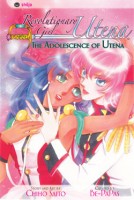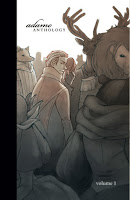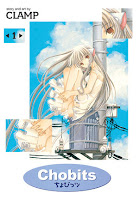 Creator: Chiho Saito
Creator: Chiho Saito
U.S. publisher: Viz Media
ISBN: 9781591165002
Released: November 2004
Original release: 1999
Revolutionary Girl Utena is one of my absolute favorite anime series. Despite that fact, I’ve never read any of the Revolutionary Girl Utena manga until now. I have no idea why that is. I love manga, and I love Revolutionary Girl Utena, so it would seem obvious that I should want read the Revolutionary Girl Utena manga. Maybe I was simply afraid that I would be disappointed by it. Turns out—at least with Revolutionary Girl Utena: The Adolescence of Utena—I probably shouldn’t have worried. The Adolescence of Utena manga by Chiho Saito is an alternate version of the animated film Adolescence of Utena which in turn is a retelling of sorts of the Revolutionary Girl Utena anime series. Saito’s The Adolescence of Utena was originally released in Japan in 1999, the same year as the film. In English it was first serialized in Animerica Extra, a shoujo-leaning monthly manga magazine published by Viz Media between 1998 and 2004, before the manga was collected and released as a single volume in 2004.
Utena Tenjou is a new student at the prestigious Ohtori Academy, known for its elegance, traditions, and ceremony. What she didn’t realize was that her ex-boyfriend Touga Kiryuu is also enrolled at the school and is president of the student council, no less. Two years ago he left her and, in response, Utena decided to take control of her life and become her own prince instead of waiting around for Touga or some other man to fill that role. But upon her arrival at Ohtori, Utena is quickly swept up in a mysterious series of duels between the members of the student council that will determine the fates of those who fight as well as the fate of a young woman named Anthy Himemiya, the Rose Bride. The winner of the duels earns the right to do whatever he or she desires with the Rose Bride, gaining the power to change and remake the world however is seen fit. All of those involved, even Utena herself, have tragic pasts and dark secrets, but Utena is the only one who is able to look beyond all of those and see Anthy as more than an object to be won.
I have always found it difficult to summarize Revolutionary Girl Utena or to adequately explain just how meaningful the series is to me. Revolutionary Girl Utena has a strange but powerful narrative with many, many layers to it. The same is true of The Adolescence of Utena manga; it just seems impossible for me to truly do the work justice. Although certainly more direct and straightforward than its film counterpart, the manga is still incredibly surreal and rife with symbolism. Almost nothing is exactly what it initially seems and almost everything is open to multiple interpretations and analyses. The imagery itself is very dreamlike—architecture that defies the laws of physics, floating castles, flurries of rose petals, gardens that shouldn’t be able to exist, and so on—but Saito captures it all beautifully. There is an ethereal quality to her artwork that suits The Adolescence of Utena remarkably well, whether the manga is meant to be a dream, purgatory, a metaphor, or something else entirely. Both the story and the art of The Adolescence of Utena are intensely psychological, deeply emotional, and highly sexually charged.
The Adolescence of Utena is in many ways a distillation of Revolutionary Girl Utena, crystallizing many of the original series’ themes into a single volume. I was actually rather impressed by how much Saito was able to retain and how complex the tale remained even in a condensed form. The manga will probably be appreciated most by those who are at least familiar with Revolutionary Girl Utena, but it also carries some significance and effectiveness as a separate work in its own right. The relationship between Utena and Anthy is absolutely key to the story as the manga explores love of different types—romantic, illicit, familial, sexual, and many others—as well the multitude of intersections between those types of love, both good and bad. And just as important as love is to The Adolescence of Utena, so are the feelings and emotions of despair and desperation as each of the characters, all of whom are broken or damaged, struggle in their own way to try to reclaim their lives and who they are. Much like the original Revolutionary Girl Utena, I found The Adolescence of Utena to be an exceptionally compelling work.















